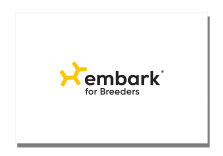Spinocerebellar Ataxia with Myokymia and/or Seizures
Known as the "oldest" (even reptiles and more ancient species have them!) part of the brain, the cerebellum fine-tunes motor signals from the brain to the muscles, allowing for balance and coordination. When the cerebellum does not function properly, dogs become uncoordinated and do not have the ability to perform fine motor skills.
-
Signs and symptoms
The most significant clinical sign of the disorder is cerebellar ataxia; affected dogs often also display myokymia, an involuntary quivering of a group of muscles or part of a single muscle, seizures, or both. As the disease progresses, the muscle quivering or myokymia can reach a point that dogs can overheat; seizures can also become progressively more severe.
Spinocerebellar ataxia (SCA) with myokymia, seizures, or both is a juvenile onset inherited disorder. Affected dogs usually begin to show signs between two and ten months of age. -
Diagnosis
Unless a genetic basis is suspected due to the age, breed, or history of the dog, diagnostics must be performed to rule out infectious, inflammatory, or neoplastic causes.
-
Treatment
There is no treatment for this disorder. Certain medications may be prescribed to control symptoms.
-
What to do if your dog is at risk
Actions
- Keeping your affected puppy comfortable and giving them the best quality of life you can are the only actions you can take at home.
-
Genetic Information
While originally identified in Russell group Terriers, the mutation has also been identified in populations of Smooth Haired Fox Terriers, Toy Fox Terriers, and Tenterfield Terrier (in Fox Terriers the disease is termed "hereditary ataxia"). KCNJ10 is a potassium ion channel vital for maintaining a relatively unexcitable state in the central nervous system. Loss of this KCNJ10 activity leads to increased neuron excitability and firing, which accounts for the observed clinical signs of cerebellar ataxia, seizures, and myokymia. In Russell group terriers, SCA has been mapped to a mutation in the KNJ10 gene.
This disease is inherited in an autosomal recessive manner, meaning that affected dogs must have two copies of the mutation to show clinical signs.
Gene names:
KCNJ10 ‐ chr
Inheritance type:
recessive
Citations:
-
Breeds affected
This health condition affects the following breeds
Learn about your dog’s unique genetic health
Dog owners
Breed identification, health and trait insights, personalized care recommendations, and the world’s first canine relative finder—all in one leading dog DNA test.
Learn about the report for dog ownersShop the test
Breeding programs
Embark’s test for breeding programs is one comprehensive DNA test designed with your needs in mind.
Learn about the report for breedersShop the test
















